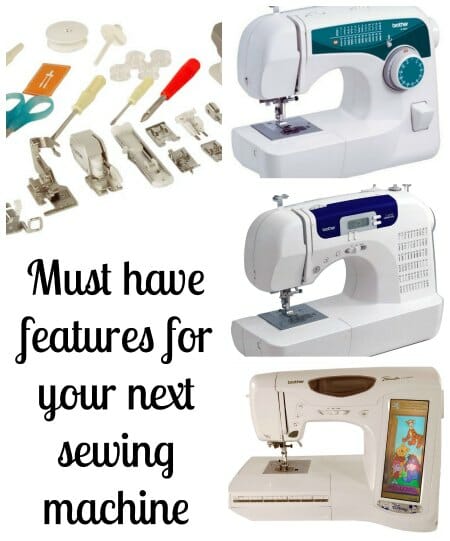
Unless you've been very lucky, most of us start out learning to sew on quite a basic machine. It may have been a shared machine at school, an old machine from the 60's your mother used to use when you were a child or even a vintage treadle machine your grandmother used to use! All are great options when you are simply learning the basics.
Every year new and improved sewing machines come to the market, but do we really need all these features, bells, and whistles they offer and entice us with? Maybe yes, maybe no. Let's take a look at some of them and tell me what you think are essentials:
The basics – the MUST-HAVE features
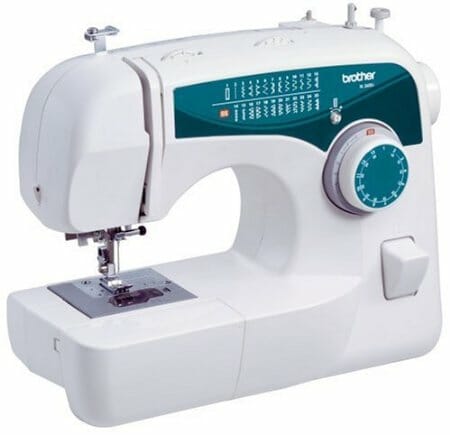

Stitches
How many different types of stitches do we really need? Think about your machine. How many stitches does it offer? 20, 50, 70, 200+ And now many of those do you actually ever use? Your machine should probably have as a minimum:
- variable length straight stitch including a long length for a basting stitch
- a variable zig-zag stitch where you can vary both the stitch length and width
- some kind of stitch for sewing with stretch fabrics, perhaps a ‘lightening stitch' or a triple zig-zag
- a backstitch – is usually a button you press on the machine to reverse your current stitch
- a buttonhole stitch
Needle threader
Not I suppose an essential, but as your eyes can tire when sewing, this can keep you on track longer and make it less of a chore to change threads or unthread the machine to wind a new bobbin. These come in two types – an automatic usually found on higher-end machines, and a manual needle threader.
A light
Sewing in a gloomy corner or late at night? Then you'll need a light and most machines would come with one as standard. These days, you can also buy additional lighting such as desktop daylight lights, or even additional strips of LEDS you can add to the machine to make sewing clearer.
Computerized or not
The lower-end machines tend to come with dials you turn to select your stitch type, stitch length, and stitch width. I started out with a machine just like this and it worked perfectly. Even some of the budget-friendly machines are now computerized and come with a small LCD screen and the ability to select stitches and features with the push of a button. But remember, the more fancy features you have, the more there is to go wrong!
A good paper manual
Even if you have been sewing for a while, you should always read your new machine manual as there may be great features on there you would be missing out on otherwise. Having a good paper manual that explains all of the stitches and when to use them gives you the opportunity to get the best out of your machine now, and as your skills grow in the future.
Customer support
Does the company have a customer support phone line? You'll most likely never need it, but if you get stuck, have a problem you can't solve, or just need some advice, it's good to know there are people at the end of the phone who can help you. Look for phone support for the life of your product and you'll never be left in the dark.
If you are buying your first machine, learning to sew, or teaching someone else to sew, you might like to print these sewing machine practice sheets to keep your stitching on track.
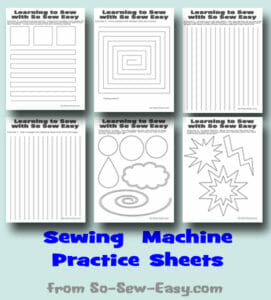

The middle ground – good to have
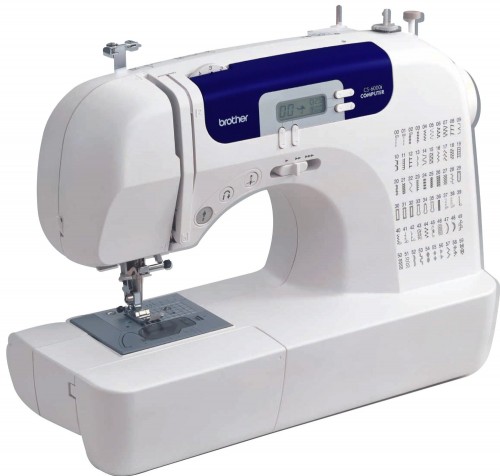

Walking foot
Sometimes called a dual feed foot. This presser foot has feed dogs built in so the top layer of fabric is pulled through the machine at the same rate as the lower layers. Great for sewing knits, quilts, bags, and anything with several layers of fabric that you want to keep even.
Automatic thread cutter
Cuts both your top and bottom threads after you stitch with just the touch of a button. No need to keep getting up to go fetch the scissors that you left over by the ironing board. ( I need this on my next machine – I'm forever leaving my scissors everywhere except by my machine.)
Extra stitches
Once your sewing skills improve, you may find yourself looking for additional stitch options. Maybe for overcasting, blind hemming, embroidery, quilting, or decorative stitches. Look for the extra utility stitches first as you'll use these more often.
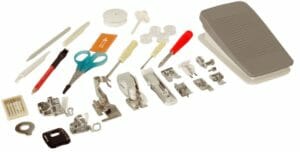

Assortment of extra feet
If your machine already comes with an assortment of feet, then that will save you both time tracking them down, and money, later on. You'll need a zipper foot as a basic, but also look out for a walking foot, blind hem foot, button, and buttonhole foot as a minimum.
Needle down selection
A button that allows the user to select the position of the needle when they finish sewing. You can decide if the needle should always be up for quick removal of your project, or always down so you can pivot and turn easily.
Variable speed control
Helpful when you are just starting out, or when working on a special project if you can select a lower speed, so even if you stamp on the foot pedal, you'll still be sewing under control. Higher speeds are useful for free-motion quilting or yards of straight lines like curtains.
Hard case
Taking your machine to class or to your local sewing group. A hard case will protect it on the way, and also keep your machine clean and shiny at home too.
Automatic buttonholes
Select your buttonhole style, slide your button into the special guide on the foot, and press the button. Let your machine beautifully and accurately sew your perfect-sized buttonhole. Some machines will come with a 4-step buttonhole function, but fully automatic makes the whole process a breeze.


Adjustable feed dogs
Most of the time you want your feed dogs to gently pull your fabric through the machine, but there might be times when you don't such as for darning or for free-motion quilting. Being able to lower those feed dogs is great to have as an option.
Adjustable presser foot pressure
Useful for differing thickness and weights of fabric and also for reducing the pressure when sewing knits, or to prevent puckering when sewing in zippers. Usually a light, medium, and regular pressure setting.
The top-of-the-range features
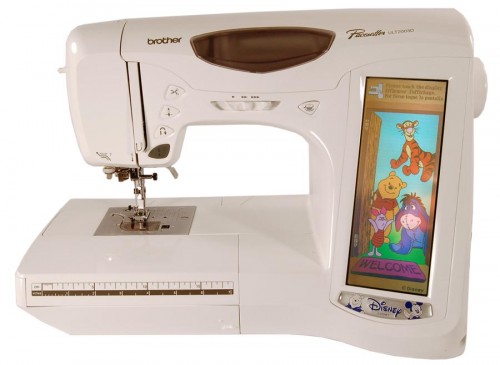

The machine shown above is pretty modest. The sky really is the limit when it comes to machine features, and price, for the top of the range sewing, quilting, and embroidery machines. They usually have take-your-breath-away features you never knew you ‘needed' until you see them in action. Here are just a few of the hundreds of features on these dream machines, that can easily cost you more than your car!
LCD touch screen
Access all of your stitches and settings, information, memory, and favorites by way of a nifty touchscreen display. Full-color display – even better.
Computer-controlled automatic tension
Never have to worry about getting things just right. Let the computer make all the correct settings and adjustments for you. In fact, almost everything is automatic and computer controlled – you just have to sit there and choose the fabric!
Embroidery
Add in your own designs, use a flash drive, attach your machine to your laptop, or sew from the included library of designs and fonts.
Large ‘harp'
The harp size of the machine is the space between the needle and the main body of the machine on the right. Some machines specially designed for quilting are wider to accommodate the volume of the quilt as you stitch.
Knee-lifter
Found only on a few domestic sewing machines, this lever can be pressed with your knee to lift the presser foot and drop the feed dogs without taking your hands off your work. Popular with quilters, and gives you an extra hand for fiddly jobs.
Laser guides
Laser guidelines for sewing, embroidery, needle placement or just to keep you sewing in a perfectly straight line. Some machines will even feed the fabric for you and keep it perfectly placed through individually computer-controlled feed dogs. Sigh, no more slightly wonky seams.
In our sewing dreams
If you had a dream sewing machine that could do anything, what features would you look for?
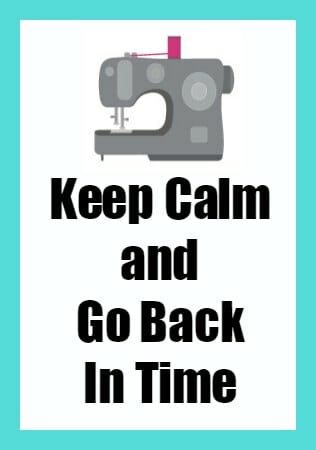

My dream machine would have a ‘back in time' button. When I'd done something silly, sewn a seam back to front, put on a sleeve inside out, I'd press this button and the machine would take it ‘back in time' completely removing my mistake and unpicking for me. Like it never happened 😉








I am one of the fortunate, a long time ago, I purchased a computerized machine designed for quilting. I use it for everything!! I love it! It has all of the features mentioned; (needle up or down, many stitches, thread cutter, etc) I already had a serger, which I also love. Took classes on that. It’s magical! I now have two sergers; one for dark colored and one for white thread. I sew a lot, obviously, including my own clothes, dolls and doll clothes, and clothes for my friends granddaughters.
Oh and also the Singer buttonholer attachment!
Just read through the comments. It’s funny how many would be quite happy with vintage upgraded to have dual feed and auto tension.
Other than dual feed, I am happy with just the basics – straight stitch, zigzag – both fully adjustable not automatic. I can do almost anything. For me the perfect machine would be a Pfaff 1222 but with an few alphabets…. It’s the only time I pull out my computerized machine.
Most machines I’ve used sew very well, and I’ve had few issues with that. But there are some features I will be looking for in my next machine purchase. 1. Get rid of that inch-long needle screw holder. It has pounded my fingers to the bone while sewing things that need close holding in small areas, like jeans patches, corners in garments, fussy sewing, bulky materials, etc. I know what a set screw is, and recognize screw drivers and their use. 2. Move the presser foot lever to the back or eliminate it altogether. Some machines have already accomplished that. It hangs up on every piece of fabric I shove under the needle. 3. Remove the buttonhole thingy to measure buttonholes. If the machine has decorative stitches, add a 3/8″, 1/2″, 5/8″, and 1″ buttonholes decorative stitches, and I won’t need anything else. These are the major problems added to the machines back in the 70’s and 80’s. Whoever redesigned the sewing machines then, never sewed anything of value in their lives. Right now, I’m looking for a working Singer treadle.
This comment is worth its weight in gold and should be read by all sewing machine companies.
http://www.sewcranky.com/
This lovely shop, above, sells hand crank & treadle sewing machines. I spent a wonderful day in their shop trying out sewing machines from around the world! Very kind & nice people & they ship machines to people too.
i ended up with a lovely hand crank sewing machine from Germany & it sews beautifully.
Automatic thread tension. It’s amazing. I can live without any extras as long as my thread tension is sorted.
I love being able to adjust the needle position. This was a new feature when I upgraded my machine a few years ago. I didn’t realize how much I used this until I taught a sewing class and the sewing machine provided at the class did not have this feature.
I have an older Kenmore that was upper middle line when I bought it. Honestly I’ve found there are very few things I can’t do on it. I would like to have some other feet for it, especially one for hemming and one for darning. As long as it works I’ll just keep using it.
If I were looking to replace it, I would want something similar. Pretty sure I don’t want a computerized one.
I like all the bells and whistles. That being said, I can’t afford most of them. I did treat myself to a quilting type machine a few years ago and I love it, but I kept my basic machine for the times the new one had to go to the spa. And then I love my solid feeling mechanical machine!
I wonder if you can buy a knee-lifter attachment to add onto a sewing machine?
Hi Shirley, as far as I know only industrial machines and some Bernina Models have it. I have a Bernina 880 B Plus that came with the attachment and I also have an Industrial Pfaff couldn’t be without either machine 🙂
A lot of Janome machines have it – I hadn’t used mine until recently but it is quite nice when you need both hands to control the fabric.
I have had my Elna for ten years now and it came with a knee lift. It is not industrial.
Sounds like a great machine!
My Brother Q450 has the knee lift.
My Juki HZL f300 hasa knee-lift. I believe all the Juki F-series machines have them.
Janome has a couple of models with knee lifter. Call a dealer for which ones.
I would wish for a machine that would put together my pattern pieces then cut them out, and if I’m really lucky it will also cut my material for me as per my instructions! lol
Due to spinal stenosis I have to push the pedal with my left foot, but if I didn’t have the hover feature on my machine I’d have to stop sewing. I cannot use a knee lift, and when doing machine applique and many other quilting techniques, the knee lift or hover are especially worth paying top dollar. For me it makes the difference between sewing and not sewing. 🙂
Space age features? A bobbin winder that works under there and feeds the bobbin with new thread! That’s a dream!
This isn’t a space age feature. Back in the early 70’s the machines in our home ec class had this feature. I’m pretty sure they were Singer’s but I’ve never seen one since. I agree it was so handy I’ve actually looked for it when I’ve bought a new machine.
I advise anyone who is looking to buy a first sewing machine to get to know the local dealer and if their budget is limited, to purchase a second hand better quality machine from that dealer. I have seen many new bargain machines that were very poor quality and the $100 or so that went to that new machine at a department store would have been better spent at the trusted reliable neighbourhood machine dealer. Also, the local dealer offers repair and service as well as teaching you how to use the machine. The dept stores don’t offer this. A good quality machine will make you sew happy.
this thought is worth considering! Can’t buy a singer as there is no support;(
I bought my Singer from the Viking dealer inside Joann and got 2 two hour classes and help whenever I need it. They also provide service and repairs.
That is SO true. And it is often true that their prices on new machines are lower than what you see in ads too. I bought Janome because the dealer is local and they have a GREAT customer service department, they support and repair all makes but they really know those Janomes. Their sales guys are better at sewing than I am.
They also have a great selection of used machines at fantastic prices because they take old machines in on trade when you buy a new one. They don’t sell them until they have repaired/refurbished and tested them. A good dealer is priceless.
I have the top of the range Pfaff and I love, love, love it, but no matter how nicely I ask, it still won’t make my coffee.
Ha ha, yes, that would be a nice feature!
I do have 2 sewing machines and a surger. I have a basic heavy duty all metal Euro-Pro. I couldn’t bring myself to trade it in on my Pfaff Ambition 1.5 and I’m so glad I didn’t. I highly recommend the Pfaff brand for the IDF. I sew jeans and use my old machine for sewing together and the Pfaff for topstitching and button holes.
A CTRL-Z button would be my favorite too!
Irene
SergerPepper.com
Biggest must-have for me is an even feed system. Purchased a Viking years ago because it had the built in walking foot, now I don’t want to sew on a machine without.
When I decided I was ready for a computerized machine, I bought a mid-range Brother. Loved it to an extent–I found computers can be extremely sensitive. I’d spend 10 to 20 minutes trying to figure out what was wrong. What I really needed was a heavy duty manual machine–No bells and whistles. I bought a Janome with all metal parts, basic stitches. Guess which one I use the most? I have a serger and coverstitch to do the complicated stuff — give me simple sewing.
I agree. I’m very happy with my simple Brother – does nothing fancy, just the essentials and because of that its easy to use.
I completely agree. I went from a high end embroidery only machine, to a mid range computerized machine. Now I have a Janome low end and it’s my favorite (along with my 15 year old bernina serger)
I was contemplating upgrading my Singer 10 stitch machine but after I bought it a walking foot and auditioned stitches using my manual I was really pleased with my machine’s performance with knit fabric. Does anyone else find that machines aren’t as well built and sturdy as they used to be?
Yes, the old aluminium machines of the sixties and seventies are well built and sturdy. Mine has a button-hole feature and some extra stitches. After adding the walking foot it sews even better.
I do have a modern computer machine also, mainly for the many buttonholes and even about a hundred different stitches. I do use those stitches, It makes a repaired seam look like the stitching was not a repair but an enhancement.
I took a class at a quilt show last fall & the sewing machine they provided did not have a hand wheel!! Instead there was a button on the front of the machine that I pushed to have the needle come up partway; then I had to guess & pray it would come down where I wanted it when I pushed the button again (my eyesight isn’t good enough). I use the hand wheel all the time to get my needle in the exact spot I want it & I use my knee lift to bring the needle up partway. I’d never had a knee lift before I bought my current machine & it was at least a year before I got the hang of it but now I love it. But at that class last fall I spent half my time with my right hand reaching for the hand wheel & my right knee reaching for the knee lift.